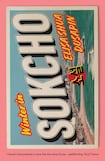
"Our beaches are still waiting for the end of a war that's been going on for so long people have stopped believing it's real." In Sokcho, a tourist town on the border between South and North Korea, people are used to waiting. They wait for the end of a decades-long conflict between north and south. They wait for the winter to pass and the snow to be over. They wait for the tourists to return, to bring some money to a region that is mired in poverty and neglect.
The unnamed narrator of this engrossing debut novel is also waiting – for change, for something to happen, for her adult life to begin. Finished university, she has returned to her hometown to work in a guest house and be near her mother. Her boyfriend Jun-Oh visits occasionally but is more concerned with establishing a modelling career in Seoul. The narrator’s days all have similar shape: she cleans, changes bed linen, cooks for the guests, eats her mother’s food. But when a stranger comes to town, in the form of Kerrand, a French writer and artist, the narrator sees her life and town through his eyes and soon becomes restless for change.
Winter in Sokcho is an enigmatic, beguiling book that documents stasis and the helplessness felt by someone trying to overcome it. Even as she tries to show Kerrand her hometown, hoping to inspire him to write about it, she realises, “He’d never understand what Sokcho was like. You had to be born here, live through the winters. The smells, the octopus. The isolation.”
Dusapin is equally adept at depicting exterior landscapes. In this atypical seaside town: “We walked past an expanse of concrete. An observation tower rose up in the middle of it, pumping out the wailing of a K-pop singer. Restaurant owners dressed in yellow boots and green baseball caps stood in front of their fish tanks, waving their arms around to attract customers.” The conflict with North Korea makes for interesting background detail. Smaller aspects of Korean culture also pop throughout the book, from the sulphur baths, or jjimjilbang, where the narrator and her mother go for a soak, to the haenyeos, the diver women who search for shellfish deep down in the sea.
Dusapin is a stylish writer interested in the emotional life of her characters. Born in France in 1992, she was raised in Paris, Seoul and Switzerland. Published in French in 2016 to wide acclaim, Winter in Sokcho (L'Hiver en Sokcho) was awarded the Prix Robert Walser and the Prix Régine Desforges, and has since been translated into six languages. It is easy to see why. This finely crafted debut explores topics of identity and heredity in compelling fashion. In its aimless, outsider protagonist there are echoes of Sayaka Murata's Convenience Store Woman and Jen Beagin's Pretend I'm Dead. Dusapin's writing on the female body recalls the likes of Sylvia Plath's The Bell Jar, Margaret Atwood's first novel The Edible Woman, and more recently Alexandra Kleeman's You Too Can Have a Body Like Mine.
Thwarted desires
The connection between food and the female body is a recurring topic. The narrator’s thwarted desires often manifest in binges. She develops an obsession with cooking for Kerrand. Elsewhere, she overeats in the company of her mother: “[She] topped up my bowl, smiling happily. I felt sick. I carried on eating and drinking, stuffing myself. It was always the same when I was with her, I couldn’t stop myself.” The narrator blames her body for her stasis, her unhappiness, “eating frantically, filling this body that stifled me, stuffing myself until I couldn’t breathe, and the more I ate the more I disgusted myself, the more my lips twitched, my tongue fumbled, until I slumped to the ground, drunk on sausage, while my stomach heaved and vomited bile onto my thighs”.
Desire and disgust frequently intermingle in this book, the narrator exchanging one for the other as she seeks to find a way out of her current predicament
Issues of heredity also show themselves through food: the mother is the only woman in Sokcho able to prepare an infamous and lethal blowfish dish, while her daughter can’t cook an octopus without bursting the ink sack. Just as the narrator feels bound to care for her mother, she also longs to be away from her, learning French at university so she can speak a language her mother won’t understand. Desire and disgust frequently intermingle in this book, the narrator exchanging one for the other as she seeks to find a way out of her current predicament.
The answer, it turns out, is not in a man, or at least not in the traditional sense of a relationship. Throughout the book, the narrator is jealous of Kerrand’s art, how it consumes him, how it takes his attentions away from her. Towards the end of this short, engaging novel, she has come to realise what she wants from him: not to be saved, but rather to be seen.













